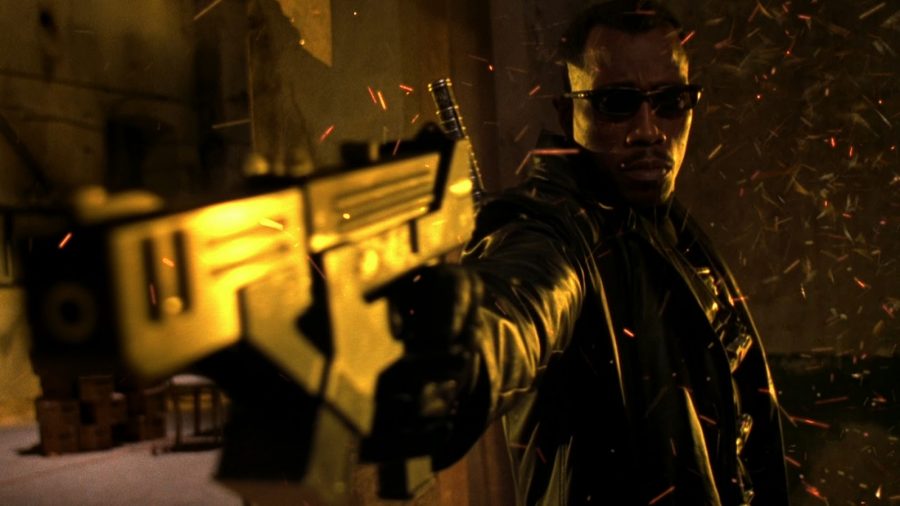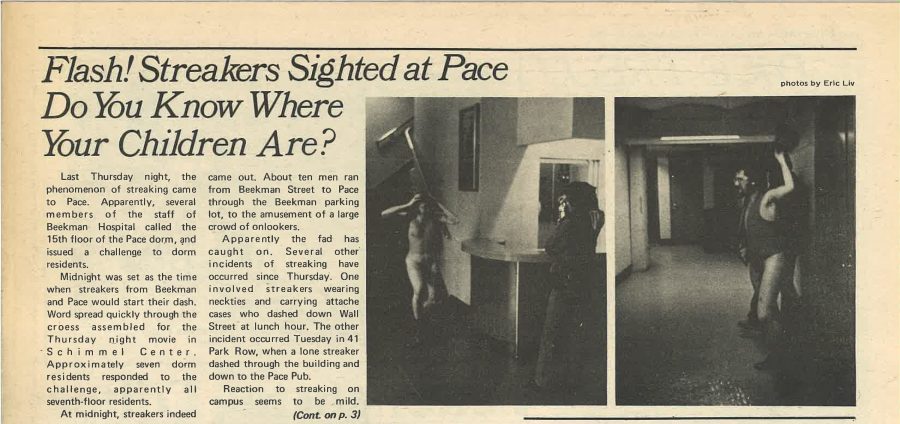In light of the University’s new plans to overhaul One Pace Plaza, we’re throwing it back almost 50 years, to the birth of the Manhattan campus as we know it. Then called the Civic Center Campus, the cornerstone was laid in 1968 in a ceremony attended by local dignitaries and Pace leaders, many of whom credited the power of the students to affect change at their university and beyond—still an apt statement half a century later. Read on to find out what the Pace Press, Pres. Mortola, and a size 14 mini skirt all have in common!
Originally published April 24, 1968. Written by Eileen Singer, Class of ’68.

Last Thursday, April 18, was a memorable day, for on that day a dream came true. The dream began by 1958 with a flicker of light and an addition to Pace. But it was not till last Thursday that the cornerstone for the new Civic Center Campus was layed [sic], thus fulfilling that long-standing dream.
The ceremony took place at the corner of Nassau and Spruce Streets where a red, white and blue-draped platform had been erected. Nature evidently approved for she sent us a pleasant day. Could there have been a more appropriate natural backdrop than those powerful, steel beams and solid, cement foundation?
James Devlin, President of the Evening Student Council, presided over the ceremony and delivered short histories of each speaker prior to his address.
The Invocation was presented by Reverend Robert C. Hunsicker, Vicar of St. Paul’s Chapel and was followed by Dr. Edward J. Mortola, President of Pace College.
Dr. Mortola summed up the ceremony, which was organized in its entirety by the students, as a “progress report written in steel by the strong hands of students.”
He saluted the whole student body, in general, and specifically, Arnold Kriss, President of the Day Student Government Association, James Devil and Santo Crisafulli, Vice President and I.C.C. for the active and unselfish part these students played in successfully organizing and carrying out the ceremony.
The proximity of the new Civic Center Campus to the Beekman Hospital would add immeasurably to the consequences of both institutions and would provide both with a deep bond.
Of great importance in Dr. Mortola’s speech was the acknowledgment that the expansion of the campus would serve as a helping hand to those in a disadvantaged position, so that they, too, may pursue a college education. This also appeared as a strengthening of the noble program already in action at Pace.
Dr. Thomas J. McShane, Chairman of the Pace College Faculty Council, commented that the laying of the cornerstone was only literal; that figuratively speaking, that cornerstone had been set in place over the entire history of Pace by its faculty, staff, administration and trustees.
That the ceremony had been so well organized proved to the faculty that the students were free and willing to participate in college affairs.
Arnold Kriss, Coordinator of the ceremony, spoke on behalf of the student body. He examined the future role of the student with regard to arising “valid grievances,” and stated that “purpose” is the criterion by which these grievances should be judged.
The ceremony serves as an example of student power put to good usage and it is hopeful that more students will be included on faculty committees for activities, services and curriculum planning. In this way “new and old problems could be discussed with mutual understanding.”
Mr. Allan Rabinowitz, President of the Alumni Association, claimed that the physical progress of building would lead to greater progress; the interchange of thought among faculty, students and administration. This, of course, would lead to a most desirable situation, that of “free give and take.”
On behalf of the Alumni Association, Mr. Rabinowitz presented citations to four student organizations, all of which have been [in] existence for over twenty years: Day Student Government Association, Evening Student Council, Torchbearers and Pace Press.
The main address was presented by Dr. Edward J. Steiniger, member of the Advisory Council. Dr. Steiniger recognized the growing voice of the student in protest rallies, political efforts and college affairs. The basic purpose of education, to create interest in government, has been realized as students seek to relate to Vietnam, the computer, racial differences and the changing moral climate. And this is justly so, for the impact of government on the student is tremendous; the student is called upon for his support of government projects.
There is a need for greater understanding on the part of the student. He must realize that “schools must live and work within their resources” and that often it is not solely financial problems that stand in the way of reform, but taste, ethics, morals, law and the ideals that stand behind good education. Students are looking for more power but they should keep in mind that “responsibility is the obligation of power.”
Dr. Steiniger also claimed that there is a need for “communication, cooperation and consensus instead of confrontation.”
The actual laying of the cornerstone was performed by Dr. Samuel Miller, Chairman of the Board of Trustees of Pace College, who also provided light humor as he listed items to be included in the time capsule, some of which are: the last edition of the Tribune, Pace Press, Pace banner, history of Pace by Brooks Atkinson, the Pace accounting book, currency, and a mini skirt— size 14.
An Ecumenical Blessing of the cornerstone was followed by the sealing of the cornerstone with trowel and cement, and the ceremony closed with the singing of the Pace Alma Mater.


